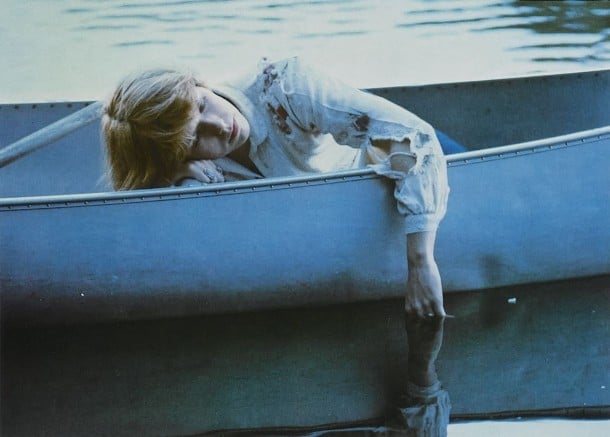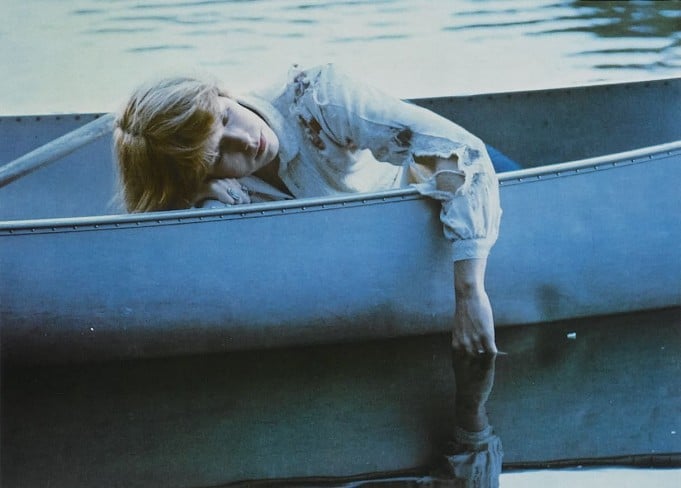
I had a chance to re-watch Friday the 13th, the ultra low budget 1980 film that set the industry abuzz–much like John Carpenter’s POV wizardry did with Halloween a few years earlier. It proved that the horror genre could reach large audiences. Decades later Scream would brilliantly satirize the then generic formula; ironic enough given its director, Wes Craven, had a significant role to play in shaping the modern day horror film with his groundbreaking Nightmare on Elm Street.
But it’s Friday the 13th that should most be credited (or disparaged) for launching the 80’s slasher craze. Unfortunately no one would top Sean Cunningham’s sleeper. This is a film that, in retrospect, had everything going for it: an amazing Pyscho-inspired score that to this day has to be one of the most memorable of modern cinema; creepy killer POV (that was in fact first used in 1974’s Black Christmas); solid-enough acting (Godfather by horror film standards); and that twist.
Forget the dreadful sequels. The original, just like the original Nightmare, and the original Halloween were masterworks. Nothing after would come remotely close, nor could it.
But that twist was a stroke of genius.
When people today think about this film series they invariable think of Jason. Jason Voorhees! But, if you’ve been following along and know your Scream trivia, you know that’s a red herring.
I remember reading a comic in grade school and seeing a promo for the film. It said something to the effect that IF YOU HAVE A HEART ATTACK WHILE WATCHING THIS FILM WE WILL PAY YOU $25,000. I thought, wow! This is really scary. These guys are really concerned about the safety of the audience. I shook a little even then just reading that ad over and over (I wish I could remember the name of that comic book, though I definitely remember the thumbnail-sized shots of Raquel Welch in a fur bikini). If Twitter were around the clever marketing campaign likely would’ve gone viral.
When I took a break from so-many re-watches of Mulholland Drive, and pulled up F13, I was reminded at just how well the film has held up over the years.
In fact, it looks as if it could’ve been shot on the new Blackmagic Cinema Camera that everyone in the indie film community is so excited about these days. There’s gorgeous grain to the film stock, and the picture has lovely dynamic range — the ghostly quality helps set the mood perfectly. No CGI, no mattes, no After Effects. Critics complain about the shoddy camerawork. But I don’t see it; save for a few oddities where the tripod or camera apparently gets knocked and the shot is inexplicably not trimmed properly by the editor. Actually there’s several pretty shots, not Paul Thomas Anderson pretty, but I think much of the film’s criticism centers around the extensive use of a handheld camera. That choice serves the subject matter well. Panic and fear don’t necessarily correlate with image stabilization.
“Kill scenes” became art nouveaux thanks to some inventive (and gruesome) scenes. Kevin Bacon pays the price for rollicking about with another counselor. A hitchhiker is chased into the woods by an unknown driver. But “Marcie” takes it to a whole new level–death performance art?–when she pulls back curtains of shower stalls in search of someone playing a prank. Yes, turns out someone indeed did have an ax to grind.
Like Jamie Lee Curtis in Halloween, a strong female lead emerges. Perhaps it’s a “Little Red Riding Hood” syndrome of sorts. We see it to this day. Check High Tension and The Descent for heroines that may have been influenced by their predecessors.
My favorite scene: the canoe epilogue on the lake.
Even though I know exactly what’s going to happen, it still makes me jump to this day. The only other film I can recall that does the job was the film adaptation of Steven King’s Carrie. To get chills, to jump up, and to feel for a moment some danger, is truly a fun reason why the horror genre can be so thrilling.
Here’s a fun Friday the 13th infographic that summarizes the entire series (that would be twelve F13 films in total!):



